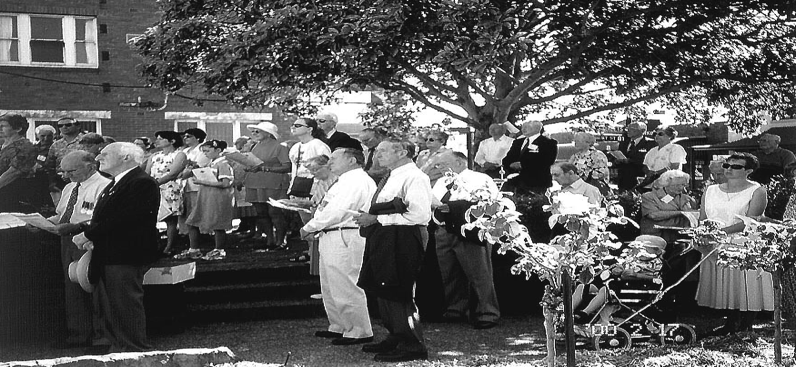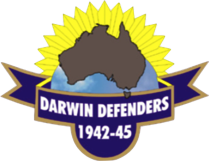----- WHEN WAR CAME TO AUSTRALIA -----
As it is today....
A look at where the Darwin Defenders were during the war - as it is today.
First to be featured is Coomalie Creek where the R.A.A.F. had an airstrip and at times there were over 20,000 personnel in the area.
31 Squadron Beaufighters R.A.A.F. -
On 3rd November 1942, and after a period of training, the squadron moved to Coomalie Creek in the Northern Territory. On the 17th November 1942, the squadron conducted its first operational sortie from its new base, when six aircraft raided Japanese positions in the Timor. The Squadron operated predominantly from Coomalie Creek Airfield for the next two years, from where it flew operations attacking Japanese shipping, shore installations, and Japanese airfields.
87 Squadron R.A.A.F. -
Initially equipped with Mosquito and Wirraway aircraft, No 87 Squadron was formed from elements of No 1 Photographic Unit on 10 September 1944. Based at Coomalie Creek, No 87 Squadron provided photo reconnaissance support for Allied air force operations to the north of Australia. The Squadron's Mosquito and Lightning aircraft were ideally suited to the aerial reconnaissance role, as their manoeuvrability and high speed meant that enemy aircraft rarely troubled them.
Other units also had personnel based at Coomalie and they are listed at the bottom of this page.
(Coomalie August 2017)
Other units also had personnel based at Coomalie -
NO 12 SURVEY DESIGN UNIT
Parent Unit; 61 Wing
This Unit undertook field surveys, design and architectural work.
NO 61 WORKS WING AIRFIELD CONSTRUCTION
Subordinate Units 1, 3 & 8 Airfield Construction Squadron. 1, 3 & 8 Works Maintenance Unit. 1, 3 & 8 Mobile Works Units. 9 Mobile Works Unit, 9 Works Maintenance Unit, 11 Works Supply Unit, 1 Survey and Design Unit. The Unit was established at Camp Pell, Royal Park, and Victoria, on 7th January 1943. It was created as an administrative unit to oversee the RAAF construction units in the Northern Territory.
NO 1 AIRFIELD CONSTRUCTION SQUADRON – (1 MOBILE WORKS SQUADRON)
Parent Unit - 61 Works Wing (Airfield Construction) Engineers Arm. Formed at Ascot Vale in Victoria on 6 April 1942. Moved to Flemington 20 April 1942. Moved to Pine Creek 6 July 1942. Soon after went to Coomalie.
Renamed 1 Airfield Construction Squadron 20 July 1944. Departed for Morotai 22 January 1945. Departed Morotai for Tarakan 27 April 1945. Disbanded 30 November 1945.
NO 3 MOBILE WORKS SQUADRON – (3 WORKS MAINTENANCE UNIT
Parent Unit - 61 Works Wing (Airfield Construction) This unit was renamed several times but while at Darwin this name was used. The headquarters remained in Darwin but detachments worked on a number of airstrips in the Northern Territory. It was disbanded October 1945
NO 9 AIRFIELD CONSTRUCTION SQUADRON
Alternative Unit Name; 9 Works Maintenance Unit
Originally formed as 9 Works Maintenance Unit. The Squadron deployed to the Northern Territory July 1943. There were detachments at Larrimah, Livingstone, Strauss, Hughes, Coomalie Creek, Darwin and Howard River. They were bombed 12 November 1943 by a single aircraft. Men from the Unit were posted south from September 1944. They went on to serve in Balikpapan, on the east coast of the island of Borneo, in the Indonesian province of East Kalimantan. The Squadron was disbanded 15 December 1945
NO 14 MOBILE WORKS SQUADRON
Parent Unit - 61 Works Wing (Airfield Construction) The Unit was formed as 14 Mobile Works Squadron 20 July 1943 by splitting 1 Mobile Works Squadron into 2 units. It was reformed at Ransford in Victoria 5 January 1944. They operated from Coomalie and Winnellie in March 1944 before moving to Truscott in Western Australia by May 1944. On 15 September 1944 they landed in Morotai.
NO 1 MEDICAL RECEIVING STATION RAAF (Medical Arm)
This Unit was formed at Daly Waters on the 23 March 1942. Initially equipped with a mobile surgical van donated by the Prahran Patriotic Society in Victoria. The Unit moved to Coomalie Creek in August 1942 where they experienced their first raid. On 16 February 1945 the Unit moved to Nightcliff. Disbanded February 1946.
No 1 PHOTO RECONNAISSANCE UNIT RAAF (Recon Arm)
The Unit was formed at Laverton in Victoria June 1942. Initially it was issued with 6 Brewster Buffalos but these were replaced with 2 F4 Lockheed Lightnings in October 1942. The Unit was renamed, 87 Photo Reconnaissance Squadron RAAF. It flew; Buffalo, Lancer, Lightning, Wirraway, and Mosquito.
31 SQUADRON.
Parent Unit 77 Wing RAAF -- 79 Wing RAAF ( Fighter Arm)
54 OPERATIONAL BASE UNIT
Logistics branch that was established at Hughes in June 1942. Moved to Batchelor in October 1942. Moved to Coomalie Creek November 1942, and finally to Venn in February 1943. Disbanded March 1943
NO 2 RESERVE PERSONNEL POOL RAAF
Alternative Unit Name 2RPP. The Unit was formed at Coomalie Creek July 1944 and moved to Winnellie 19 September 1945 before being disbanded on 30 January 1946.
90 BOMBARDMENT GROUP
Subordinate Unit – 319 Bombardment Squadron U.S.A Bomber Arm.
319 Squadron of this Group flew from Iron Range in Queensland to Fenton in January 1943. They flew long range bombing missions in B24 Liberators against the Japanese from Fenton. A number of crews from 320 Squadron were attached to 319 during their deployment in the Northern Territory.(Coomalie)
NO 51 WIRELESS SECTION
Parent Unit; Australian Special Wireless Group
Camped at Coomalie Creek between 1942 and1945. Main role to intercept and record Japanese Army, Navy, and Air Force Kana Signals. Their intercepts were sent to the navy cryptology section in Melbourne via RAAF Signals Darwin. They enciphered their messages to Melbourne in a secret cipher before passing them over to the RAAF Signals personnel. This ensured that their intercepts of Japanese Kana code or encoded messages were not apparent to other military personnel to protect the secrecy of their intercept operationThe Unit played a huge role in the warning of impending Japanese attack on Darwin and shortening the war in the Pacific.
NO 2 WIRELESS UNIT (Signals Arm)
This unit monitored Japanese Wireless signals
NO 3 WIRELESS UNIT (Signals Arm)
This unit also monitored Japanese Wireless transmission
NO 11 SIGNALS UNIT
The Unit was formed on 6 December 1942. It arrived at 57 1/2 mile 21 January 1943. Personnel from the Unit served in the Cox Peninsula - Groote Eylandt - Fenton - Batchelor - Gove - Truscott - Coomalie - Tindal - Gorrie and Darwin erecting cable and aerial system buildings and installing radio equipment. The Unit was disbanded 22 August 1944.
NO 8 WIRELESS TRANSMISSION STATION
Previously been a detachment of No 11 Signals Unit. Other names are; North Western W/T Station - NWA HQ telecommunication Unit - NWA Telecommunications Unit - Darwin Signals Unit. The Unit was formed 15 July 1944. It had a number of name changes over the course of its life before disbanding February 1946.
NO 112 LIGHT ANTI-AIRCRAFT REGIMENT
Subordinate Units; 160 Light Anti-aircraft Battery. 161 Light Anti-aircraft Battery. The Regiment was raised at Healeseville Victoria. The Regiment took over the guns from the departing 2/1 Light Anti-aircraft Regiment.
NO 2/1 LIGHT ANTI-AIRCRAFT REGIMENT
Subordinate Units; 2/1 Light Anti-aircraft Battery. 2/2 Light Anti-aircraft Battery
Formed in Egypt from 2/1 Heavy Anti-aircraft Battery on 22 August 1941,it was equipped with Bofors guns and served in Syria and Egypt. On 31 January 1942, the unit embarked on the Orcades. They disembarked at Sumatra but immediately rejoined the ship because Singapore had fallen. They disembarked at Adelaide on 15 March 1942.
An advance party left by air for Darwin on 24 March 1942. By early April, the Unit was providing defence at the Civil and RAAF Dromes and at Hughes Field. On 4 April, 2 battery guns were in action and credited with downing two Japanese Zeros. 1 Battery was first sited at Batchelor where the Headquarters was also located. They fought side by side with the machine gunners of the US 102 Anti-aircraft Battery.
In June 1943, they handed over their guns and equipment to 112 Light Anti-aircraft Regiment and 149 Battery and returned to Sydney prior to embarking for New Guinea. They were at Hughes and Coomalie Creek between April 1942 to June 1943
NO 2/2 LIGHT ANTI-AIRCRAFT BATTERY
Parent Unit; 2/1 Light Anti aircraft Regiment. This Battery had 9 guns deployed at Batchelor and 2 at Pell Field, 65 Mile.as well as Coomalie. On 30 July 1942, the 2/1 and 2/2 batteries exchanged locations. The Unit reached Sydney by 25 June 1943 and were given leave.
NO 160 LIGHT ANTI-AIRCRAFT BATTERY
Parent Unit; 112 Light Anti-aircraft Regiment. The Unit arrived in the Northern Territory on 15 June and took up a position at Coomalie to relieve the 2/2 Light Anti-aircraft Battery.
NO 153 LIGHT ANTI-AIRCRAFT BATTERY
Parent Unit; 54 (Composite) Anti-aircraft Artillery Regiment. The Battery was originally located at Kensington in Sydney. It moved to Coomalie on 18 November 1943.
NO 149 LIGHT ANTI-AIRCRAFT BATTERY
Parent Unit; 101 Anti-aircraft Regiment. 108 Light Anti-aircraft Regiment. The battery was based in Newcastle. It arrived at Terowie on 30 May 1943. Ray Buttery was part of this Unit. A and C Troops were based at Coomalie. B and D Troops were at Fenton field. In June 1943, they received two extra guns from 233 Light Anti-aircraft Battery. They were bombed for the first time at Fenton on 30 June 1943.
NO 155 LIGHT ANTI-AIRCRAFT BATTERY
Parent Unit; 149 Light Anti-aircraft Regiment. This Unit provided reinforcements to 149 Light Anti-aircraft Battery. June 1943
NO 16 INFANTRY BATTALION
Parent Unit; 13 Brigade. The Battalion was known as the Cameron Highlanders of Western Australia. It departed from Darwin on 21 November 1944 on USAT Evangeline for service in New Britain.
They were at Coomalie between March 1943 to November 1944.
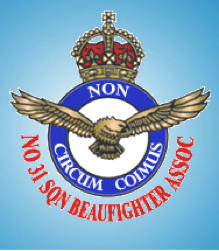
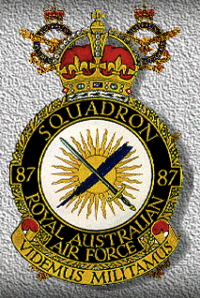
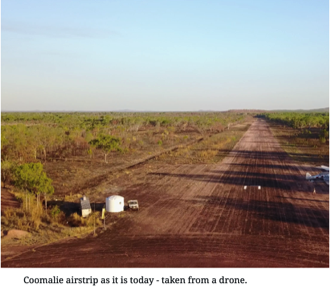
Take a drone flight down the Coomalie airstrip.
Coomalie Farm and Airstrip 2017.
Tribute featuring Coomalie.
